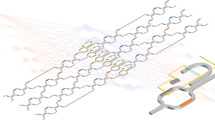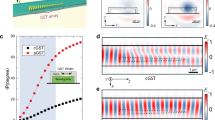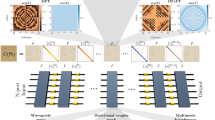Abstract
Integrated photonics, because of its intrinsic high speed, large bandwidth and unlimited parallelism, is critical in the drive to ease the increasing data traffic. Its technological enabler is high-precision lithography, which allows for the fabrication of high-resolution photonic structures. Here, in complete contrast to the state of the art, where photonic functions are predefined by lithographically modulating the real index, we report a lithography-free paradigm for an integrated photonic processor, targeting dynamic control of spatial-temporal modulations of the imaginary index on an active semiconductor platform, without the need for lithography. We demonstrate an imaginary-index-driven methodology to tailor optical-gain distributions to rationally execute prescribed optical responses and configure desired photonic functionality to route and switch optical signals. Leveraging its real-time reconfigurability, we realize photonic neural networks with extraordinary flexibility, performing in situ training of vowel recognition with high accuracy. The programmability and multifunctionality intrinsically arising from the lithography-free characteristics can lead to a new paradigm for integrated photonic signal processing to conduct and reconfigure complex computation algorithms, accelerating the information-processing speed to achieve long-term performance requirements.
This is a preview of subscription content, access via your institution
Access options
Access Nature and 54 other Nature Portfolio journals
Get Nature+, our best-value online-access subscription
$29.99 / 30 days
cancel any time
Subscribe to this journal
Receive 12 print issues and online access
$209.00 per year
only $17.42 per issue
Buy this article
- Purchase on Springer Link
- Instant access to full article PDF
Prices may be subject to local taxes which are calculated during checkout




Similar content being viewed by others
Data availability
Data that support the findings of this study are available at https://doi.org/10.6084/m9.figshare.22320649.v1.
Code availability
The computer codes that support the plots within this paper and other findings of this study are available from the corresponding author upon reasonable request.
References
Shastri, B. J. et al. Photonics for artificial intelligence and neuromorphic computing. Nat. Photon. 15, 102–114 (2021).
Feldmann, J. et al. Parallel convolutional processing using an integrated photonic tensor core. Nature 589, 52–58 (2021).
Cheben, P., Halir, R., Schmid, J. H., Atwater, H. A. & Smith, D. R. Subwavelength integrated photonics. Nature 560, 565–572 (2018).
Atabaki, A. H. et al. Integrating photonics with silicon nanoelectronics for the next generation of systems on a chip. Nature 556, 349–354 (2018).
Sludds, A. et al. Delocalized photonic deep learning on the internet’s edge. Science 378, 270–276 (2022).
Piggott, A. Y. et al. Inverse design and demonstration of a compact and broadband on-chip wavelength demultiplexer. Nat. Photon. 9, 374–377 (2015).
Bogaerts, W. et al. Programmable photonic circuits. Nature 586, 207–216 (2020).
Hughes, T. W., Minkov, M., Shi, Y. & Fan, S. Training of photonic neural networks through in situ backpropagation and gradient measurement. Optica 5, 864–871 (2018).
Arrazola, J. M. et al. Quantum circuits with many photons on a programmable nanophotonic chip. Nature 591, 54–60 (2021).
Feldmann, J., Youngblood, N., Wright, C. D., Bhaskaran, H. & Pernice, W. H. P. All-optical spiking neurosynaptic networks with self-learning capabilities. Nature 569, 208–214 (2019).
Zhang, W. & Yao, J. Photonic integrated field-programmable disk array signal processor. Nat. Commun. 11, 406 (2020).
Liu, W. et al. A fully reconfigurable photonic integrated signal processor. Nat. Photon. 10, 190–195 (2016).
Zhao, H., Li, B., Li, H. & Li, M. Enabling scalable optical computing in synthetic frequency dimension using integrated cavity acousto-optics. Nat. Commun. 13, 5426 (2022).
Zhang, W., Mazzarello, R., Wuttig, M. & Ma, E. Designing crystallization in phase-change materials for universal memory and neuro-inspired computing. Nat. Rev. Mater. 4, 150–168 (2019).
Wu, C. et al. Programmable phase-change metasurfaces on waveguides for multimode photonic convolutional neural network. Nat. Commun. 12, 96 (2021).
Wuttig, M., Bhaskaran, H. & Taubner, T. Phase-change materials for non-volatile photonic applications. Nat. Photon. 11, 465–476 (2017).
Han, S. et al. Large-scale polarization-insensitive silicon photonic MEMS switches. J. Lightwave Technol. 36, 1824–1830 (2018).
Seok, T. J., Quack, N., Han, S., Muller, R. S. & Wu, M. C. Large-scale broadband digital silicon photonic switches with vertical adiabatic couplers. Optica 3, 64–70 (2016).
Shen, Y. et al. Deep learning with coherent nanophotonic circuits. Nat. Photon. 11, 441–446 (2017).
Zhang, H. et al. An optical neural chip for implementing complex-valued neural network. Nat. Commun. 12, 457 (2021).
Ashtiani, F., Geers, A. J. & Aflatouni, F. An on-chip photonic deep neural network for image classification. Nature 606, 501–506 (2022).
Reck, M., Zeilinger, A., Bernstein, H. J. & Bertani, P. Experimental realization of any discrete unitary operator. Phys. Rev. Lett. 73, 58–61 (1994).
Nagarajan, R. et al. Large-scale photonic integrated circuits. IEEE J. Sel. Top. Quantum Electron. 11, 50–65 (2005).
Chrostowski, L. et al. Impact of fabrication non-uniformity on chip-scale silicon photonic integrated circuits. In Proc. Optical Fiber Communication Conference paper Th2A.37 (OSA, 2014); https://doi.org/10.1364/ofc.2014.th2a.37
Zhang, Z. et al. Tunable topological charge vortex microlaser. Science 368, 760–763 (2020).
Bahari, B. et al. Photonic quantum Hall effect and multiplexed light sources of large orbital angular momenta. Nat. Phys. 17, 700–703 (2021).
Mao, X.-R., Shao, Z.-K., Luan, H.-Y., Wang, S.-L. & Ma, R.-M. Magic-angle lasers in nanostructured moiré superlattice. Nat. Nanotechnol. 16, 1099–1105 (2021).
Zhao, H. et al. Non-Hermitian topological light steering. Science 365, 1163–1166 (2019).
Qiao, X. et al. Higher-dimensional supersymmetric microlaser arrays. Science 372, 403–408 (2021).
Molesky, S. et al. Inverse design in nanophotonics. Nat. Photon. 12, 659–670 (2018).
Piggott, A. Y., Petykiewicz, J., Su, L. & Vučković, J. Fabrication-constrained nanophotonic inverse design. Sci. Rep. 7, 1786 (2017).
Hughes, T. W., Minkov, M., Williamson, I. A. D. & Fan, S. Adjoint method and inverse design for nonlinear nanophotonic devices. ACS Photonics 5, 4781–4787 (2018).
Veronis, G., Dutton, R. W. & Fan, S. Method for sensitivity analysis of photonic crystal devices. Opt. Lett. 29, 2288–2290 (2004).
Rumpf, R. C. Simple implementation of arbitrarily shaped total-field/scattered-field regions in finite-difference frequency-domain. Prog. Electromagn. Res. B 36, 221–248 (2012).
Hillenbrand, J., Getty, L. A., Clark, M. J. & Wheeler, K. Acoustic characteristics of American English vowels. J. Acoust. Soc. Am. 97, 3099–3111 (1995).
Hall, K. L., Lenz, G., Darwish, A. M. & Ippen, E. P. Subpicosecond gain and index nonlinearities in InGaAsP diode lasers. Opt. Commun. 111, 589–612 (1994).
Zhang, Z. et al. Ultrafast control of fractional orbital angular momentum of microlaser emissions. Light Sci. Appl. 9, 179 (2020).
Moritz, P., Nishihara, R. & Jordan, M. A linearly-convergent stochastic L-BFGS algorithm. In Proc. 19th International Conference on Artificial Intelligence and Statistics (eds Gretton, A. & Robert, C. C.) 249–258 (PMLR, 2016).
Lenton, I. C. D., Stilgoe, A. B., Nieminen, T. A. & Rubinsztein-Dunlop, H. OTSLM toolbox for Structured Light Methods. Comput. Phys. Commun. 253, 107199 (2020).
Acknowledgements
We acknowledge support from the Defense Advanced Research Projects Agency (DARPA) Young Faculty Program (W911NF-21-1-0340), Army Research Office (ARO; W911NF-21-1-0148) and National Science Foundation (NSF; ECCS-2023780). This work was carried out in part at the Singh Center for Nanotechnology, which is supported by the NSF National Nanotechnology Coordinated Infrastructure Program under grant no. NNCI-1542153.
Author information
Authors and Affiliations
Contributions
T.W. and L.F. conceived the project. T.W. and M.M. developed the algorithms and performed simulations. T.W. fabricated the samples and conducted optical measurements. L.F. guided the research. All authors contributed to discussions and paper preparation.
Corresponding author
Ethics declarations
Competing interests
The authors declare no competing interests.
Peer review
Peer review information
Nature Photonics thanks the anonymous reviewer(s) for their contribution to the peer review of this work.
Additional information
Publisher’s note Springer Nature remains neutral with regard to jurisdictional claims in published maps and institutional affiliations.
Extended data
Extended Data Fig. 1 Illustration of the online algorithm.
a, The illustration of the geometry related to input port i and output port j. b, The spatial function f(r). The isovalue contours are the ellipses with 2 focal points at the point sources of the original (red circle) and adjoint field (blue circle). The contours become denser in the place far from the line connecting 2 ports. The white dashed ellipse shows the range \(R(r) \le R_0 = \frac{5}{4}\lambda _{eff}\), which is used for simulations in Supplementary Video 2.
Extended Data Fig. 2 Transmission measurements.
a, Dual-pump optical setup. The 1064 nm pump laser (green trace) is split into two paths for the patterned pumping and the microlaser excitation. The signal around 1500 nm (red trace) is collected by the infrared camera. VA: variable attenuator, OBJ: objective lens, DM: dichroic mirror, PH: pinhole, FM: flip mirror, BPF: band pass filter. b, Target pumping pattern and the pattern generated in experiment. The light spot on the top of the experimental pattern is the zero-order beam from SLM, which does not affect the performance as it is far away from the center. c, Spectrum collected at an input port. d, Spectrum collected at one output port with (red) and without (black) microring lasers excited. e-h Images with different excitation channels. The red and white boxes mark the position of individual microring laser and the output grating. The yellow box indicates the whole imaginary-index-driven area.
Extended Data Fig. 3 Flow chart of the in-situ training.
The initial pattern can be an arbitrary connection between the inputs and the outputs. In each epoch, the inputs and outputs related to all the samples in the dataset are measured. The pumping pattern is updated based on the measurements in the epoch until the accuracy reaches the target.
Supplementary information
Supplementary Information
Supplementary Figs. 1–7 and Table 1.
Supplementary Video 1
Offline algorithm. The left column shows the simulated electric field amplitude with different input channels excited (marked as red). The central column shows the evolution of power transmission. The right column is the target matrix and the evolution of the spatial imaginary index, the target and the simulated transmission matrix (from top to bottom).
Supplementary Video 2
Online algorithm. The same results in Supplementary Video 1 are reproduced using the online algorithm. Although the convergent speed is slightly slower than the offline algorithm, which uses precise gradients, the final performance is also excellent.
Supplementary Video 3
Measurements in one training epoch. Input and output power for 128 vowel data are recorded in one training epoch (m = 30) for vowel recognition. The input signals are encoded by the light power in eight channels on the left, and the four outputs on the right correspond to the four vowel classes. Although the contrast in the outputs is not high for the one-layer network, the integrated powers at output ports yield a nearly perfect recognition accuracy.
Rights and permissions
Springer Nature or its licensor (e.g. a society or other partner) holds exclusive rights to this article under a publishing agreement with the author(s) or other rightsholder(s); author self-archiving of the accepted manuscript version of this article is solely governed by the terms of such publishing agreement and applicable law.
About this article
Cite this article
Wu, T., Menarini, M., Gao, Z. et al. Lithography-free reconfigurable integrated photonic processor. Nat. Photon. 17, 710–716 (2023). https://doi.org/10.1038/s41566-023-01205-0
Received:
Accepted:
Published:
Issue Date:
DOI: https://doi.org/10.1038/s41566-023-01205-0
This article is cited by
-
Reviving holographic photonic integration
Nature Photonics (2024)
-
Lithography-free reconfigurable photonic processor
Nature Photonics (2023)



